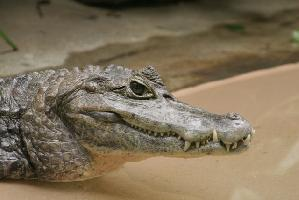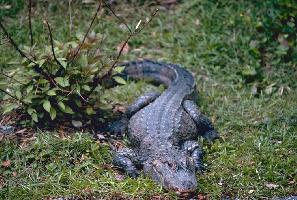
Ismert mint
- Aligátor mississippský
- Aligátor americký
- Aligátor štikohlavý
- Kajman štikohlavý
Súlyok és méretek
| Hossz | 5,5 m |
|---|
Állatleírás
The American alligator (Alligator mississippiensis) is a fascinating and formidable reptile that resides primarily in the southeastern United States, including Florida, Louisiana, and parts of Texas. This species, which has roamed the earth for millions of years, surviving the test of time, is an iconic symbol of the wild and untamed wilderness of the American South.Physically, the American alligator is an imposing creature, with adult males typically reaching lengths of about 11 to 15 feet (3.4 to 4.6 meters), while females are slightly smaller, averaging around 8.2 feet (2.5 meters). Exceptionally large individuals can exceed lengths of 16 feet (4.9 meters) and weigh over 1,000 pounds (450 kilograms), making them one of the largest reptiles in North America. Their bodies are robust and muscular, with a broad head, short legs, and a powerful, laterally flattened tail that serves as a propulsive force in water. Their skin is armored with bony plates known as osteoderms or scutes, which provide protection against predators and rough environmental elements.
The coloration of the American alligator varies with age and environment. Juveniles sport a bright yellow and black striping that gradually fades as they mature into the darker, olive or black hues seen in adults. This coloration provides excellent camouflage in their murky aquatic habitats.
American alligators have a formidable set of teeth, with 74 to 80 teeth in their jaws at any given time. As they wear down or lose teeth, new ones grow in, with an alligator potentially going through 2,000 to 3,000 teeth in a lifetime. Their powerful jaws can clamp down with tremendous force, making them adept at capturing prey but can also close gently enough to carry their offspring.
These reptiles are apex predators within their ecosystems, playing a crucial role in maintaining the balance of their environments. They feed on a variety of prey, including fish, birds, turtles, and mammals, employing a "sit-and-wait" strategy to ambush their food. Young alligators primarily consume small prey like insects, amphibians, and small fish, gradually taking on larger prey as they grow.
American alligators are known for their remarkable nesting behavior. Females construct large mounds of vegetation, mud, and sticks where they lay their eggs. These nests not only incubate the eggs but also protect them from predators. The temperature within the nest determines the sex of the hatchlings, a phenomenon known as temperature-dependent sex determination. After the eggs hatch, the mother may protect her young for up to a year, showcasing a level of parental care not commonly observed in reptiles.
Once on the brink of extinction due to hunting and habitat loss, the American alligator has made a remarkable recovery, thanks to conservation efforts and legal protections. They are now classified as Least Concern by the International Union for Conservation of Nature (IUCN), showcasing a successful story of wildlife management and preservation.
In addition to their ecological value, American alligators hold cultural significance and contribute to the economy through ecotourism and the controlled alligator farming industry. However, as human populations expand, conflicts between alligators and people have increased, highlighting the need for ongoing education and conservation efforts to ensure the continued coexistence of humans and these magnificent creatures.
Előfordulási térkép

Hasonló állatok
Új állatfotók
Top 10 állat
- Dolphin gull (Leucophaeus scoresbii)
- Diana monkey (Cercopithecus diana)
- Moustached guenon (Cercopithecus cephus)
- Galápagos tortoise (Geochelone nigra complex)
- Japanese macaque (Macaca fuscata)
- Stone loach (Barbatula barbatula)
- Russian tortoise (Testudo horsfieldii)
- Greek tortoise (Testudo graeca)
- Common flying dragon (Draco volans)
- Vendace (Coregonus albula)

